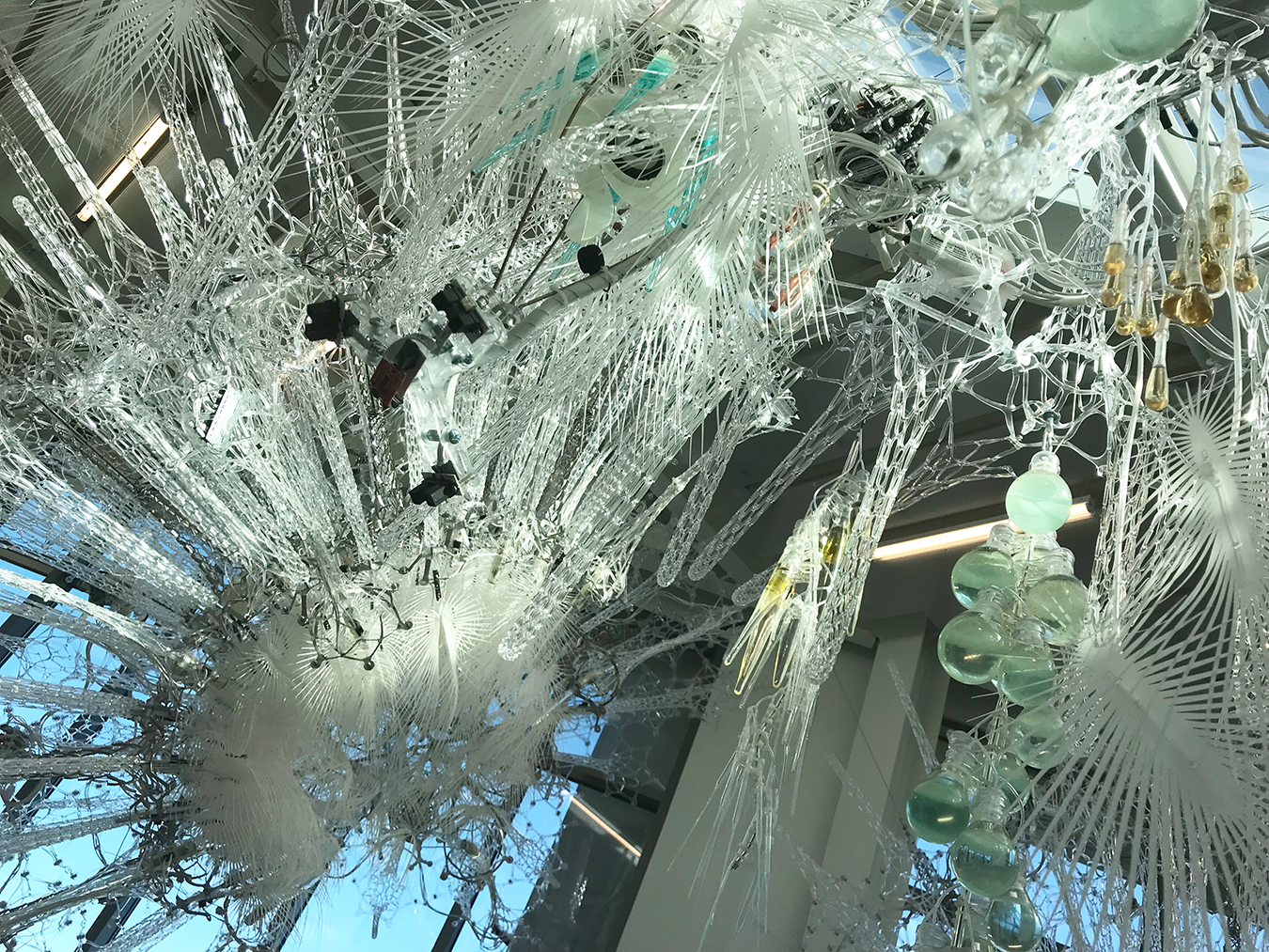
Writer and artist Samuel Welsch Sveen takes us on a stroll to look at the exceptional artwork on display “in the atriums, hallways, classrooms, and offices” of the IU campus. Paintings, sculptures, and even the “atmospheric sounds, shimmering lights, and waves of tiny movements” of Philip Beesley’s ‘Amatria,’ pictured here, represent just some of the work in this collection of treasures. | Photo by Samuel Welsch Sveen
Strolling through the Indiana University campus, you’ll notice art at every turn, both inside and out. I recently got the chance to sit down with Curator of Campus Art Sherry Rouse and ask her about a few specific pieces. She draws from a huge collection of work and decides what goes where in the atriums, hallways, classrooms, and offices all across campus. To narrow the scope of our conversation, I asked her about something old, something new, something kind of old but new to the collection, and a personal fave of mine.
Let’s start with the most-connected artist to IU, Professor of Fine Arts Harold Zisla, who created the “something kind of old but new to the collection” art. Zisla began his tenure track in 1966 at Indiana University South Bend, where he professed the fine arts up until his retirement in 1989. Like many artists, he worked through years of training and figurative paintings before finding his true style in abstract expressionism during his mid-50s.
Zisla’s works are bright and busy, swirls of color vibrating over the occasional straight-ish lines and shapes. Working in abstraction for nearly 30 years before his death in 2016, “he coupled spontaneity — achieved using blind gesture — with a rational elaboration of the images that emerged,” wrote Beverly Zisla Welber, his daughter, in an email. He believed paintings “must be alive” and sought his own, recognizable self-expression through a prolific amount of drawings, paintings, and multimedia works.
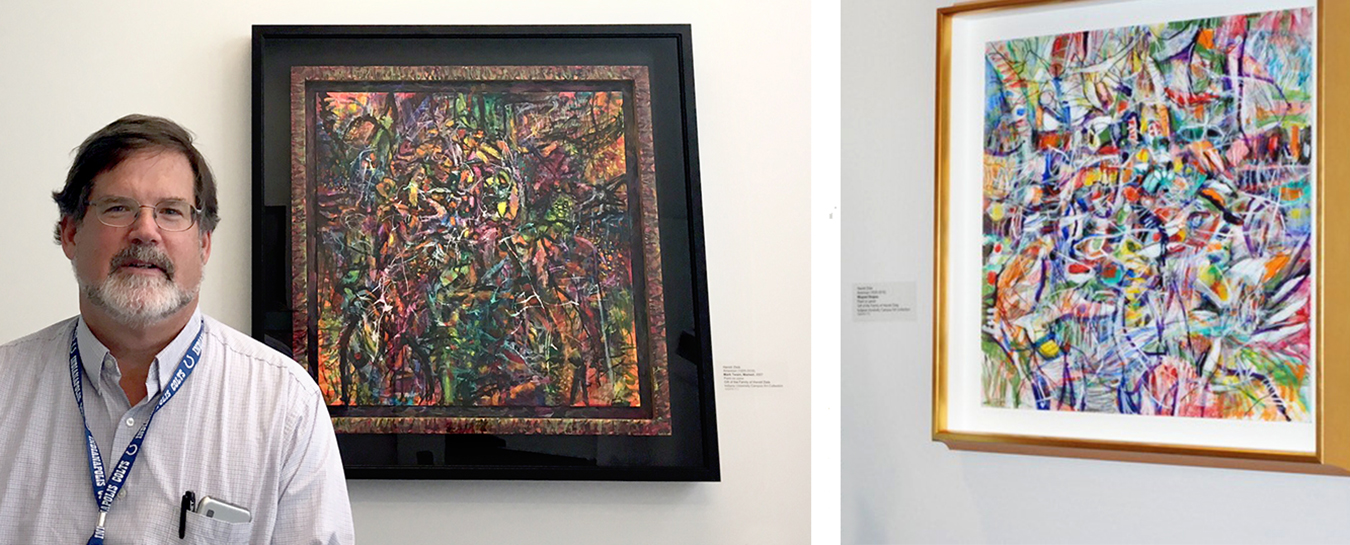
Harold Zisla’s work can be found throughout the Indiana University campus system. Two of the pieces on the Bloomington campus are ‘Mark Twain, Marked’/’Who Said You Couldn’t Use Yellow?,’ pictured left at the Cyberinfrastructure Building with David Jent, associate vice president of networks at IU’s Office of the Vice President for Information Technologies, and ‘Wisped Shapes’ at the DeVault Alumni Center. | Courtesy photos
His family continues to manage his portfolio and recently donated ten acrylic paintings to Indiana University. You can find one such painting, Wisped Shapes, currently in the DeVault Alumni Center, installed among a handful of works by other former IU professors. The rest of Zisla’s paintings will be dispersed throughout IU’s regional campuses. While many of his works remain in the state, Zisla fans span the nation and the globe — as evidenced by the selfie-full page of his website, “Me and My Zisla.”
Something old next: the big, red Alexander Calder piece in front of the MAC. This blast from the past was completed in 1970, purchased from the artist and welded on site. Calder was a successful artist known for his mobiles of colorful shapes, though he dabbled in all forms. Large metal installations like the one here were called “stabile” (as opposed to mobile, pronounced “stay-beel”). Many of the stabile pieces were already red, so it seems like a natural fit for IU!
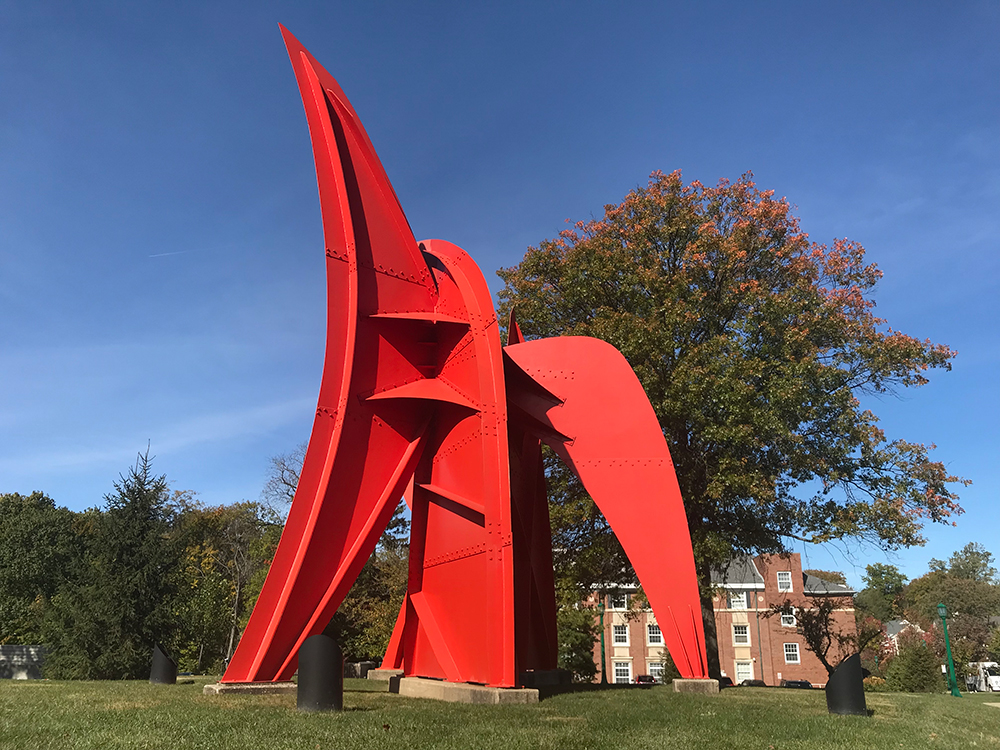
Alexander Calder’s large red sculpture in front of the MAC has a title to think about: ‘Peau Rouge.’ The work was finished in 1970 and has been repainted several times over with Calder’s iconic red. | Photo by Samuel Weslch Sveen
IU President Herman B Wells wasn’t sure it was the right fit at first, though. According to Rouse, Wells actually wanted a piece by Henry Moore, but ultimately went with Calder for a significantly lower cost. Wells sought to add a cultural icon to campus and make a statement as a sophisticated university in the Midwest.
The abstract shapes of Calder’s sculptures correspond vaguely, at best, to the titles — making the titles all the more important, I think. His title for the Indiana piece ironically highlights the state’s unfortunate history of displacing Native Americans: Peau Rouge, an offensive term (even in the ’70s), “Red Man,” hidden and/or sarcastically understated in French. While the aesthetics of the piece may feel flowy and fun, the underlying concept prods the viewer to remember a history that our country is still working through so many years later.
The sculpture was installed late in Calder’s career and he never actually made it to Indiana to see the installation; it was sent from the Calder Foundation with instructions and his specific red paint. The sculpture has been repainted several times and, in 2007, stripped down to the metal to remove layers of lead-based paint. Famously, in the 1980s, a plane was sent for rushed delivery of the official Calder Red because the primer on the sculpture was gold, and there was a game that weekend against arch rival Purdue … whose color is gold.
Brand new to campus is the interactive, computerized Amatria sculpture in the newly constructed Luddy Hall, home of the School of Informatics, Computing, and Engineering. The feathery, floaty, amoebic mixture of plastic, mylar, lights, and computer components hangs from the ceiling in the fourth-floor atrium of the new building. Atmospheric sounds, shimmering lights, and waves of tiny movements react to viewers through cameras and sensors. Try to check it out in both daylight and the dark of night for the full spectrum of experience. Amatria is a cool mess of manmade biological-like pieces, which “evokes a core theme of abiogenesis, the emergence of life during the earliest stages of development of the universe.”
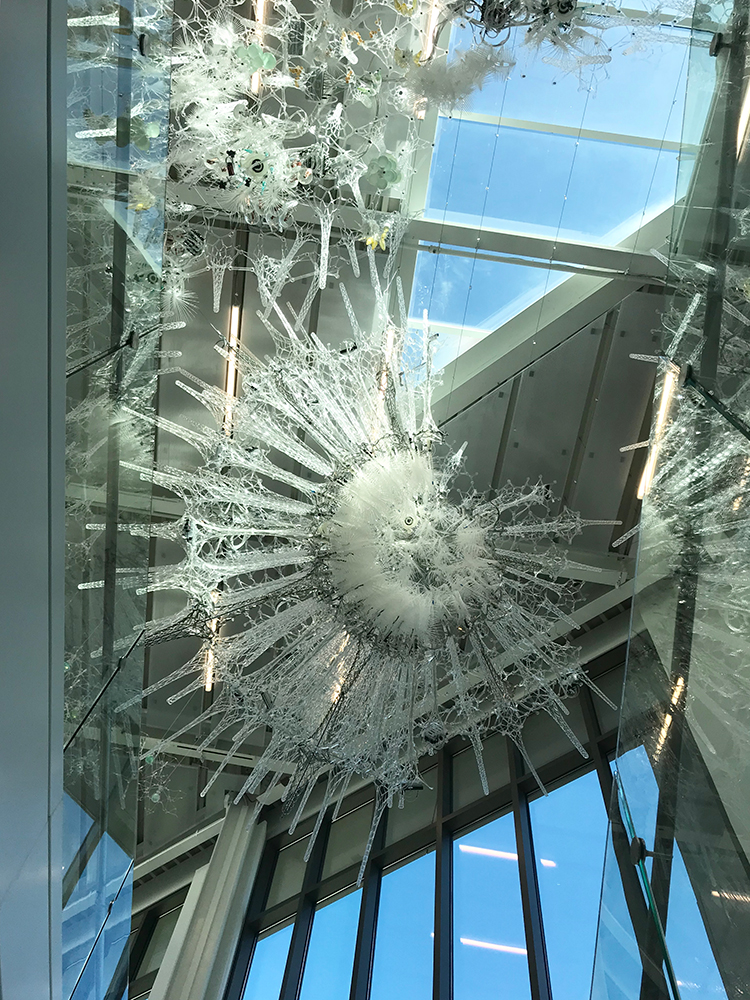
Philip Beesley’s ‘Amatria’ hangs at the top of Luddy Hall, the new School of Informatics, Computing, and Engineering building. The work responds to passers-by with small movements and noises. | Photo by Samuel Weslch Sveen
Designed by Toronto-based architect and artist Philip Beesley (the above quote is from his website), Amatria was assembled by a team of students and volunteers during the construction of Luddy Hall, but the sculpture has the potential to grow and change over time as components are repaired and replaced. Distinguished Professor Katy Börn was first impressed by Beesley at a conference in 2015 and worked to bring him to Bloomington to share his convergence of engineering and art. The artist visited campus throughout the process and for the official unveiling earlier this year.
In today’s environment of the Internet of Things, a.k.a. IoT (pronounced eye-oh-tee), students will gain valuable experience creating and coding devices to interact with Amatria. The artist has even provided software kits to help students connect with the data collected by the sculpture. This work of art serves as an experimental technology lab for students learning to build the next generation of IoT devices, from smart cars to medical interfaces. Beesley asks, “What if buildings could know us, talk to us, and even care about us?”
Last but not least, my personal favorite: the clean lines and simple shapes of Charley Harper’s wildlife paintings. You can recognize his work all over campus by the flat, graphic depictions of birds, bugs, and other critters. By flat, I mean there are no shadows or shading; perspective and depth is achieved simply through relative size. Also, they are literally flat — two dimensional.
Harper was an Ohio farm boy whose eventual advertisement illustrations were “too realistic,” as he wrote in a letter to a colleague later in his career. This seeming failure is what led him to his successful, pared-down style. It also led him to the technique of screen printing, and he was able to make many prints of his work, which he claimed to like even more than the original paintings. As his career took off, he made several murals and posters for various companies and government organizations, created illustrations for nature books and children’s books, and taught design and illustration at the Cincinnati Art Academy.
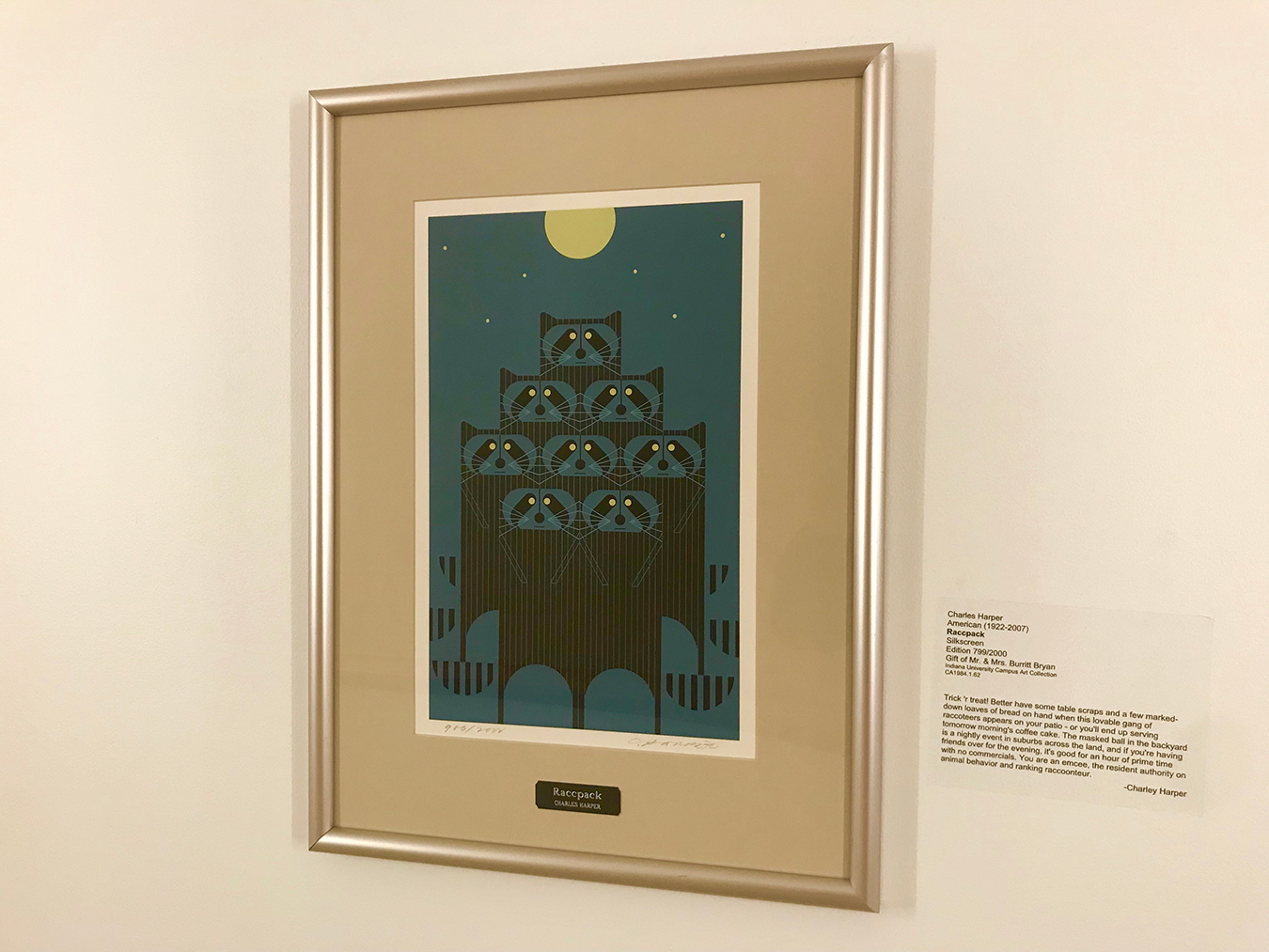
An example of Charles Harper’s graphic wildlife illustrations, Raccpack is a silkscreen edition found in the IMU down the hallway to the left of the bowling alley, toward the office of the Dean of Students. | Photo by Samuel Weslch Sveen
I first noticed his work on the way to the bowling alley in the bowels of the Indiana Memorial Union (IMU), but IU has a huge collection and Rouse has dispersed the works all over campus: in the Kelley School of Business, the Multidisciplinary Science Building II on North Walnut Grove Street, and more. Harper’s family donated all of the works to IU, and nearly all of them are signed screen prints. Rouse estimates that about 90 percent of the works are wildlife themed, with a just few hot air balloons to look out for.
If you made it this far, you’ll notice that all of the above artists are old (or deceased) white dudes. Rouse said that, indeed, most of the artists in the IU collection are old white men, such as T.C. Steele and Thomas Hart Benton. But more and more, artists of different backgrounds are emerging, and art by and of people of color — such as multiple paintings by Bloomington’s own Joel Washington — and women can be found once you start looking for it.
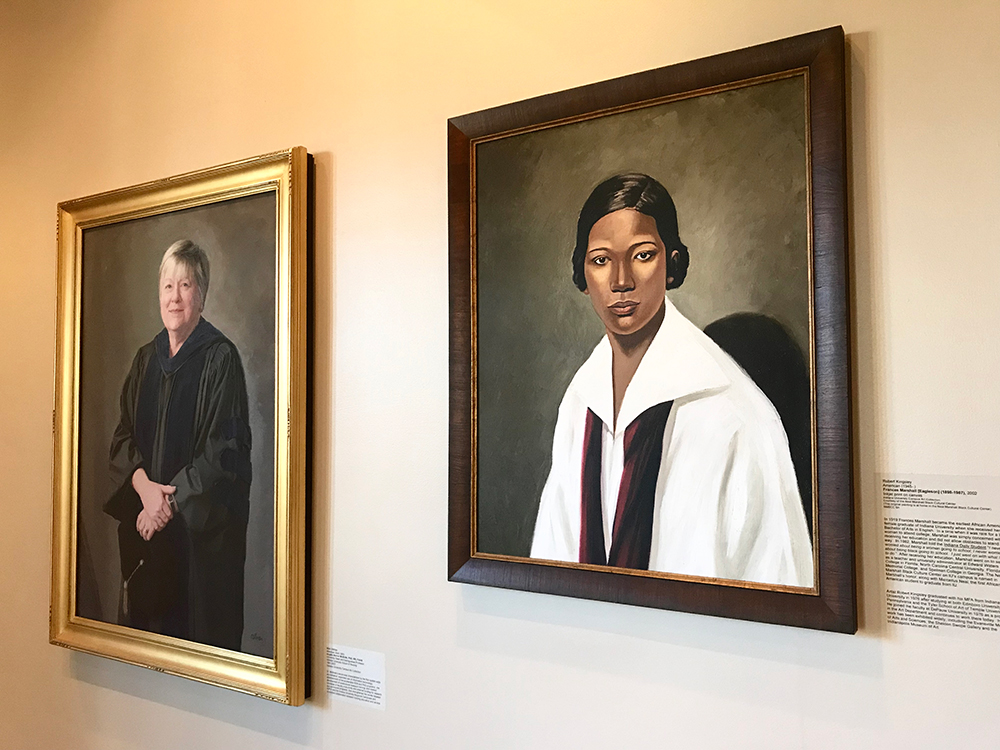
A portrait (right) of Frances Marshall hangs in the Women of Indiana University collection in the IMU’s East Lounge, next to one of Angela Barron McBride, a dean and distinguished professor in the School of Nursing. Marshall was the first African American female to graduate from Indiana University (1919). | Photo by Samuel Welsch Sveen
In 2013, Rouse installed the popular collection Women of Indiana University in the IMU’s east lounge, above the hotel lobby. Portraits of women, from Nobel Prize winner Elinor Ostrom to the first female assistant football coach at IU, Elizabeth “Buzz” Kurpius, line the walls, as well as two original artworks — not portraits — by Martha MacLeish and Peg Zeglin Brand. Many of the portraits were painted by women, too. Rouse continues to receive calls from other women of IU, excited for the project and eager to be included.
Another example cited by Rouse is at the Nelson Administration Building, 801 N. Jordan Ave., where a portrait of Alice McDonald Nelson hangs near the entrance. Like many of the women of IU, she wore a number of hats — including that of the occasional backhoe tractor driver. Known especially for her reimagining and revitalizing of the residence hall system, she took the finances from red to black in just one year. Nelson created the first co-ed dorms, deciding that if boys and girls could live together at home, they surely could at school. Adding telephones to dorms was another accomplishment, and her system set a precedent that many other universities followed.
While IU’s permanent collection of works made by women and more diverse artists is still extremely low in comparison to the collection of works done by men, it’s growing. Rouse also points out that other forms of recognition are growing too, like the naming of buildings.
The collection continues to grow and evolve, including more and more artists every year. Now that you’ve seen my photos, keep an eye out for the arts IRL (in real life) and take a minute to stop and smell the paint.

